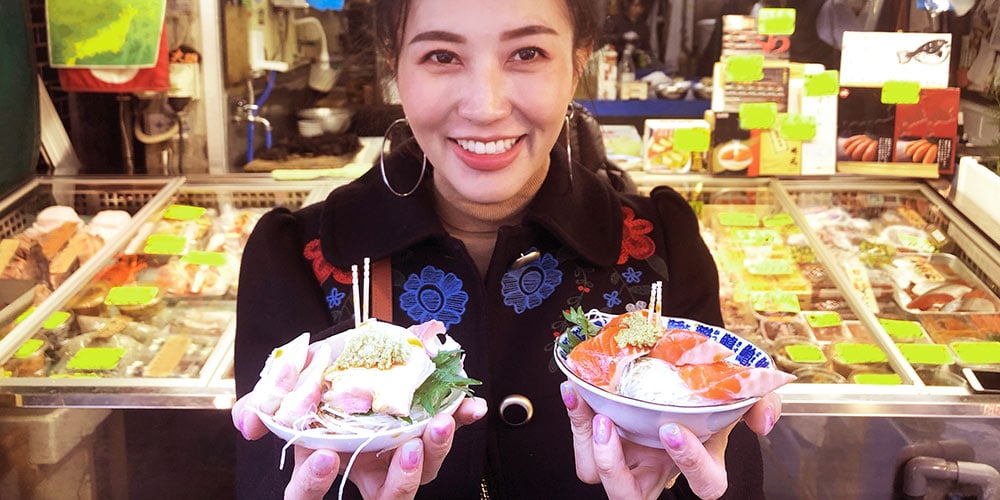Here’s what might happen if you don’t read our learn basic Japanese to survive guide…
You’re strolling through the streets of Tokyo. The sun is beating down on your face. ‘Is this what happiness feels like?’, you ask yourself. You have a wonderful day planned and your Japanese is going to make that possible. A quick train ride to the hotel, check in, and straight out for some sushi. I’m starving!
But wait. How do I get someone’s attention again? What was the Japanese for excuse me? I need to double-check with someone that I’m heading in the right direction.
And so it begins. You feel yourself losing it – and you’ve only just arrived!

Don’t let this be you. Instead, learn Japanese not just to survive – but thrive! – in Japan! And communicate with confidence.
‘Excuse me’ in Japanese:
‘umm, excuse me?’ = ‘anō’ (あのー) (used for getting attention)
Learn Basic Japanese to Survive
Your first time talking with locals in Japanese can be scary. That’s why you need some super useful words & phrases to help you out.
The point of learning a language is to use it, right?
That might seem obvious. But it’s amazing how many language learners forget about real-world competence. Learning loads of verbs, grammar, and words is great… but not if you don’t use them!
Equipping yourself with a Japanese survival kit takes the anxiety out of speaking. Keep these in your back pocket (or in our app 👋) to help memorise them.
Learn these basic Japanese words & phrases
Hello/good day konnichiwa (こんにちは) |
What is your name? o namae wa? (おなまえは) |
I am... watasha wa... desu (わたしは…です) |
Excuse me/I'm sorry sumimasen (すみません) |
No, that's not right chigai-masu (ちがいます) |
Yes, exactly sō desu (そうです) |
Incredible! SUGOI すごい” or saikō desu! さいこうです! |
May I ask you a question? shitsumon o shite mo ii desu ka? (あのー、ちょっとすみません) |
How to ask for directions
Where is the train station? densha no eki wa doko desu ka? 電車の駅はどこですか ? |
Which direction? docchi どっち? |
Ask someone to repeat something
Japanese locals will be happy to repeat anything and be super impressed with your speaking efforts! Remember you’re a language learning superstar. 🌟
Slowly, please yukkuri onegai simasu (ゆっくりおねがいします) |
please say that one more time mō ichido itte kudasai (もういちど 言ってください) |
These will become your back-pocket Bible. Your get out of jail cards. We’re going to show you more phrases on this page, but if you want to learn these Japanese greetings (and more) quickly, check out all the Japanese greetings and we’ll teach you when you download the Memrise app.
Next up… let’s tell you about the written characters that make up the Japanese language!
Learn Japanese Alphabet
To navigate your way through Japan like a knife through butter – you’ll need to recognise some written symbols!
How to learn Japanese alphabet (hiragana, katakana and kanji)
Do I need to learn the Japanese alphabet to survive in Japan? Well… the ‘alphabet’ isn’t quite the right word. Japanese language has 3 written scripts of symbols or characters: hiragana, katakana and kanji.
- Hiragana – 46 syllabic written characters that are spoken to make sounds (and form sentences with kanji!).
- Katakana – 46 syllabic written characters of words stolen from other languages!
For example:
- Coffee (in English) = kōhī (コーヒー)
- Ice cream (in English) = aisu kuriimu (アイスクリーム)
- Japanese Kanji (漢字) = symbols that show the meaning of things!
For example: sushi = 寿司
Even if your goal isn’t to be a Japanese expert, learning some Japanese Kanji is very useful - especially the numbers. Take a look at the numbers you’ll learn in Kanji when you learn Japanese with our app here.
Why do I need to learn Japanese characters?
These are your survival symbols! They’ll help you:
- Work washing machines: turning all your clothes orange on day 1 isn’t a great start. Plus Japanese showers and toilets (with their different flush options!)
- Operate the TV remote and watch cool Japanese TV shows.
- Travel in all forms: by plane, bus, taxi and on foot. And buy any tickets you need.
- Check into your accommodation in style.
- Order mouth-watering Japanese food from a menu.
- Navigate your way around cultural attractions easily.
- Using the right gendered bathroom!
- Use a cashpoint without stress.
Spot these survival signs and you’ll come off as a real pro! See these 3 examples of when they’ll come in handy.
1) Paying for things: 円
The Japanese currency is 円 (yen). For reference:
Approx: $10 = 1100 円 £10 = 1506.86 円 €10 = 1305 円
You’ll need this for travel, accommodation, food & drink, everything. This really is a survival sign!
Can you spot the price: 円 below? 👀

Something to look out for: Japanese prices show without VAT (to show what companies are sharing you) and a price with VAT (this is what you’re paying!). Look for 税込 ('zei-komi', meaning tax-including), ignore 税抜 (without tax).
2) Withdrawing money: 出
Next challenge. You’re at the cash point and your head’s about to explode! But it’s not because of all the Japanese sake you just tried.

To withdraw cash, click on:
出 (outside, to exit) = meaning "taking OUT money"
入 (to enter) = "to make a deposit into the account"
Easy! These kanji are also used as part of the signs:
入口 = entrance
出口 = exit
Helpful, right?
3) Going to the bathroom: 女 or 男
How to ask someone ‘Where is the bathroom?’ in Japanese?
Or look for the Kanji (お手洗い) or Hiragana: (おてあらい) toilet. 2 options: use the correct bathroom or give someone a heart attack…
Remember that: 女 (woman) 男 (man). You do the rest.
Look. These don’t just prevent anxious sweaty palm moments. They let you immerse yourself and communicate with people! Buy your new friend that beer. Call that cab. Invite someone over for dinner! Put simply: create exciting new life experiences through language.

Want to know more Japanese symbols? Course you do. Click on our Intro to Japanese Scripts course to discover more cool symbols and characters that make up the language!
Learn Basic Japanese
Planning your travels? Or perhaps you want to live & work in Japan? Either way – calling on key words & phrases for any situation means you’ll be doing it in style.
Learn Japanese words & phrases
Learning how to say hello in Japanese is a good place to start:
konnichiwa (こんにちは) = hello
Here are some useful Japanese words to keep in your back pocket (*downloading our app makes this possible… just saying 😉).
Please onegai shi-masu おねがいします |
thank you arigato (ありがとう) (casual) |
thank you arigatō gozaimasu ありがとうございます (formal)
|
thanks Dōmo (どうも) is our favourite - a casual ‘thanks!’ |
There is no direct translation ‘thank you very much’ so here are 3 ways to express your thanks in Japanese.
You're welcome dōitashimashite (どういたしまして) |
nice to meet you hajimemashite はじめまして (before introduction) |
|
nice to meet you yoroshiku onegaishimasu (よろしくおねがいします) (after introduction) |
good luck gambatte! (がんばって!) |
|
how are you doing? genki? (げんき?) (casual) |
i'm good, that's unnecessary ī desu (いいです) |
|
thanks for the food itadakimasu (いただきます) (before meal) |
thanks for the food gochisōsama desu (ごちそうさまです) (after meal) |
Special occasion
|
Happy New Year akemashite omedetō gozaimasu! (あけましておめでとうございます!) |
Happy Birthday otanjōbi omedetō (おたんじょうびおめでとう) |
|
Merry Christmas merīkurisumasu! (メリークリスマス) |
Let's go sā, iki-mashō さあ,行きましょう |
You can listen to a bunch more of super useful (real-life relevant!) phrases spoken by native Japanese speakers. How? Start learning NOW!
Learn Japanese Grammar
The importance of Japanese grammar depends on your reasons for learning Japanese. Need to learn to write Japanese to craft a Japanese novel worthy of Haruki Murakami? You may want to spend some time. Looking to survive and thrive in Japan without drama? Try to remember these essential survival points:
- The sentence order is usually subject-object-verb.
This takes some getting used to, especially for English speakers used to their subject-verb-object sentence structure. So instead of ‘I eat Ramen’, the Japanese is ラーメンを食べます (Ramen I eat)
- The particle “ha: wa” tells us the topic of a sentence! (は)
- The articles “a”, “an” and “the” do not exist in Japanese
- “desu” and “masu” sounds at the end makes the sentence polite
- “you” (あなた) is rarely used and it is more natural leave it out in conversation
- “ne?” (ね) at the end (or one its own) is a sound for inviting agreement. “ne?” “neee?” = “don’t you agree?” “you think so too, right?”
- Adding “ka” (か) at the end changes a sentence into question
So there you have it! Make these words, phrases and signs your back-pocket Bible to survive in Japan. Remember these as you learn Japanese and you’ll cruise around Japan with confidence.
Did you enjoy learning these phrases? If you did, supercharge your language learning and get the Memrise app. We’ve built the course around real-life scenarios and situations so you can choose what’s more important and relevant to you. Want to learn Business talk you’ll use in an office in Tokyo? Or how to talk about Technology with someone who is just as into gadgets as you are? Or maybe you want to impress someone in hopes that they’ll be Falling in Love with you and your new found Japanese skills. If it doesn’t work out, you can always learn how to Break Up too.
What we’re saying is that what some people consider as “useful phrases” may not be the same as someone else’s. Our app lets you get to the phrases most important to you - you’ll never be forced to learn anything you won’t find useful again!









